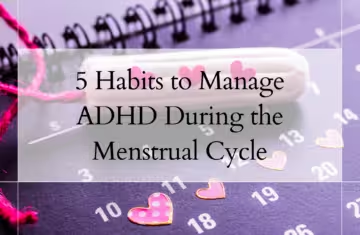Let me be honest with you for a moment—PMDD has been a part of my life too, and it’s no joke. Some days, it felt like an uphill battle: the rollercoaster of emotions, the physical discomfort, and that overwhelming sense of frustration when nothing seemed to help. Maybe you’re in that space right now, wondering how to manage it all. If that’s you, I see you. And I want you to know, there are ways to feel better.
One of the biggest game-changers for me (and for many women I work with) is focusing on food. Not dieting or deprivation, but choosing nutrient-packed foods that help support your hormones, balance your mood, and ease some of those relentless symptoms. It’s not a quick fix, but it’s a powerful, sustainable way to take back control.
So, let’s talk about the foods that can make a real difference in managing PMDD. These aren’t magical cures, but they’re tools that can help you feel more like yourself again. Let’s dive into the top 9 foods that can help with PMDD and why they work.
Here are my top 9 anti PMDD foods to eat.
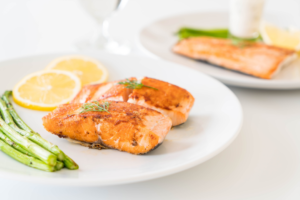 1. Fatty Fish for Omega-3 Fatty Acids:
1. Fatty Fish for Omega-3 Fatty Acids:
Omega-3 fatty acids are known for their anti-inflammatory properties, making them a cornerstone in the PMDD diet changes. Fatty fish like salmon, mackerel, and trout are rich sources of these essential fats. Studies suggest that omega-3s can help alleviate mood-related symptoms associated with PMDD by reducing inflammation and supporting brain health.
Incorporate at least two servings of fatty fish per week into your diet for a notable omega-3 boost. There are some great recipes over on Healthy Food Guide if you need recipe ideas. If you’re not a fan of fish, consider omega-3 supplements, but always consult with a healthcare professional before adding new supplements to your routine.
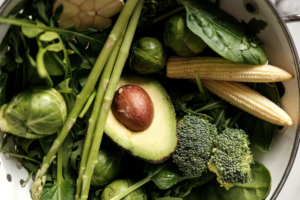 2. Leafy Greens for Magnesium:
2. Leafy Greens for Magnesium:
Think spinach, kale, and Swiss chard. These are packed with magnesium, a mineral that’s basically your best friend when it comes to PMDD. Magnesium helps relax your muscles (goodbye cramps) and calms your nervous system, reducing anxiety. Plus, these greens are full of iron, which you might need if heavy periods leave you feeling drained.
Consider adding a magnesium-rich salad to your lunch or incorporating sautéed greens into your dinner rotation. Experiment with different recipes to find enjoyable ways to include these nutrient-dense greens in your diet.
3. Whole Grains:
Quinoa, oats, and brown rice are brilliant for keeping your blood sugar stable. When your blood sugar is steady, you’re less likely to feel those hangry mood swings or sudden energy crashes. Bonus: whole grains also provide fibre, which supports healthy digestion and helps your body eliminate excess oestrogen.
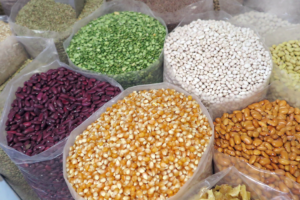 4. Legumes:
4. Legumes:
Lentils, chickpeas, and black beans are rich in iron, making them essential if heavy periods leave you feeling wiped out. They’re also packed with protein and fibre, giving you long-lasting energy and keeping you full.
5. Berries:
Blueberries, raspberries, and strawberries aren’t just delicious—they’re packed with antioxidants and vitamin C. These nutrients help reduce inflammation and combat bloating, plus they satisfy your sweet tooth without sending your blood sugar on a rollercoaster.
6. Turmeric for Anti-Inflammatory Support:
Chronic inflammation is a contributing factor to various PMDD symptoms. Turmeric boasts potent anti-inflammatory and antioxidant properties. Including turmeric in your diet may help mitigate inflammatory responses, providing relief from discomfort.
Add turmeric to your cooking by sprinkling it on roasted vegetables, incorporating it into soups, or making a flavourful turmeric tea.
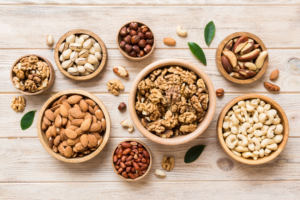 7. Nuts and Seeds for B6:
7. Nuts and Seeds for B6:
Almonds, walnuts, and pumpkin seeds are little nutrient powerhouses. They’re high in vitamin B6, which helps with mood regulation and hormone balance. Plus, pumpkin seeds are a great source of zinc and magnesium—two key minerals for easing PMDD symptoms like irritability and cramps.
8. Fermented Foods:
Yoghurt, kefir, and sauerkraut contain probiotics that support gut health. Why does this matter? Your gut and brain are closely connected, and a healthy gut can mean a happier, more balanced mood.
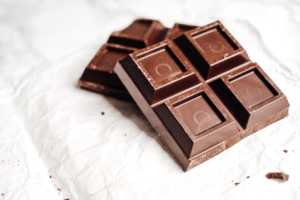 9. Dark Chocolate for Magnesium and Serotonin Boost:
9. Dark Chocolate for Magnesium and Serotonin Boost:
Dark chocolate, in moderation, can be a delightful addition to your diet. It not only provides a boost of magnesium but also stimulates serotonin production, contributing to a sense of well-being. Not to mention, one of the tastiest foods to help with PMDD!
Choose high-quality dark chocolate with at least 70% cocoa content. Enjoy a square or two as an occasional treat or incorporate it into recipes like smoothies or desserts
Supplements That Can Help with PMDD
Food is a fantastic starting point, but sometimes you need a little extra help. Here are some supplements that can make a big difference:
Magnesium: This mineral is amazing for calming your nervous system, easing cramps, and even improving sleep. Look for magnesium glycinate or citrate for better absorption and aim for 200-400 mg per day.
Vitamin B6: Known for its role in mood regulation, B6 helps produce serotonin and dopamine (your feel-good hormones). It’s also great for reducing bloating and irritability. Aim for 50-100 mg per day, or consider a B-complex supplement.
Zinc: Zinc supports hormone balance and can reduce PMS and PMDD symptoms like mood swings and acne. Aim for 15-30 mg per day, but always take it with food to avoid stomach upset.
Iron: If you’re feeling tired and weak, low iron could be the culprit. Choose a gentle form like ferrous bisglycinate and pair it with vitamin C to boost absorption. Always check with your GP before supplementing iron.
Building Habits That Stick
Managing PMDD isn’t just about adding a few superfoods to your plate. It’s about creating habits that support your overall health. Here are some key steps:
Eat Consistently: Skipping meals can send your blood sugar on a wild ride, making mood swings worse. Aim for balanced meals with protein, healthy fats, and fibre.
Move Your Body: Exercise releases endorphins, your body’s natural mood boosters. Whether it’s a gentle walk, yoga, or dancing in your kitchen, find something you enjoy.
Manage Stress: Chronic stress can make PMDD symptoms worse. Try mindfulness practices like meditation, journaling, or even a few deep breaths when things feel overwhelming.
Sleep Well: Quality sleep is crucial for hormone regulation and mood stability. Create a calming bedtime routine and aim for 7-9 hours a night.
Hydrate: Dehydration can worsen bloating and fatigue. Aim for at least 2 litres of water a day, and consider herbal teas like chamomile for extra soothing benefits.
Track Your Symptoms: Awareness is key. Use a symptom tracker to identify patterns and figure out what works best for you.
Ready to Take Control?
If you’re tired of PMDD controlling your life, it’s time to take action. Small, consistent changes can lead to big results. To help you get started, I’ve created a Healthy Habit Tracker with 6 key steps to lasting weight loss and improved well-being. It’s designed to make habit-building simple and sustainable—because you deserve to feel your best.
Download your free Healthy Habit Tracker now and take the first step toward a healthier, happier you.

Sarah Parker - Health & Life Coach
Hi, I’m Sarah, a health and life coach helping women break free from yo-yo dieting and lose weight without restrictive plans. I know the struggle firsthand—I spent years trapped in a cycle of diets, emotional eating, and guilt, always chasing quick fixes that didn’t last.
Everything changed when I stopped fighting my body and started focusing on sustainable habits and self-care. Now, I’m passionate about helping women like you build a healthy relationship with food, feel confident in their skin, and achieve lasting results—without the stress and restrictions of traditional diets.




